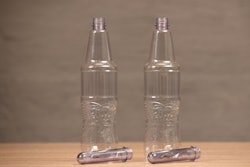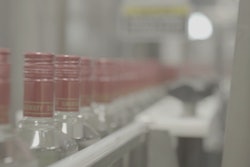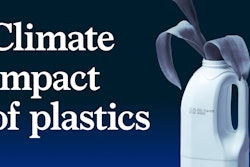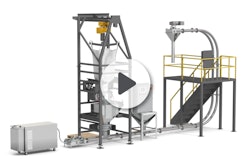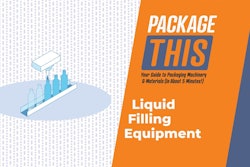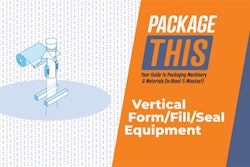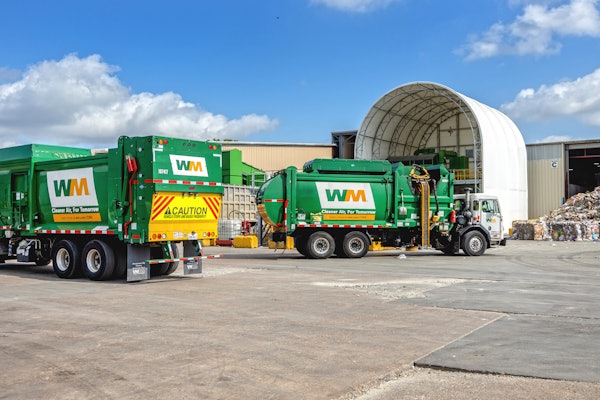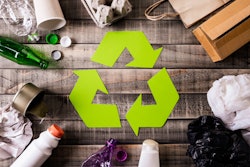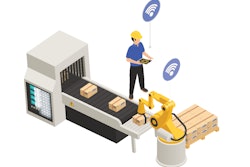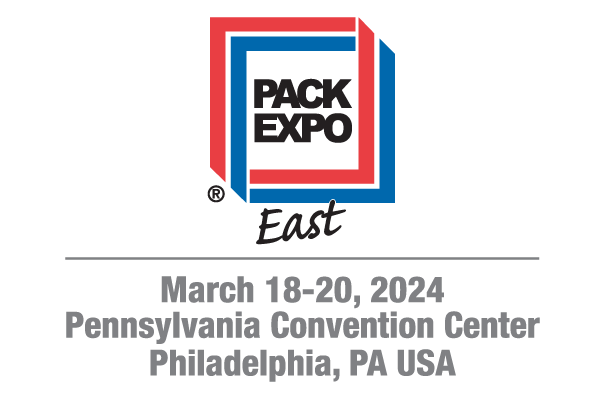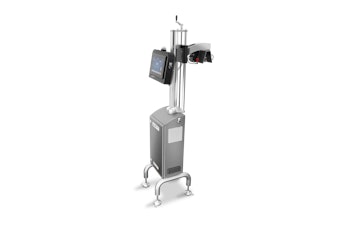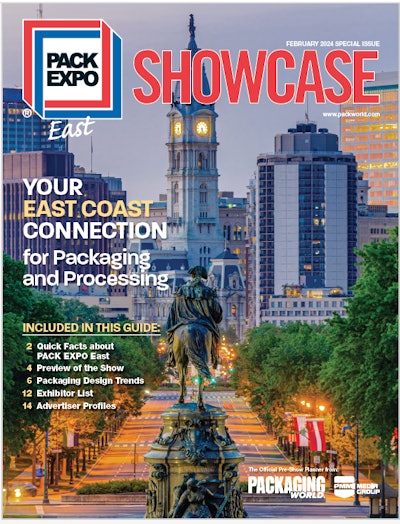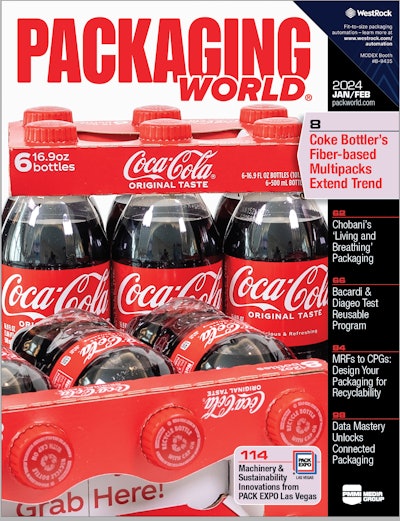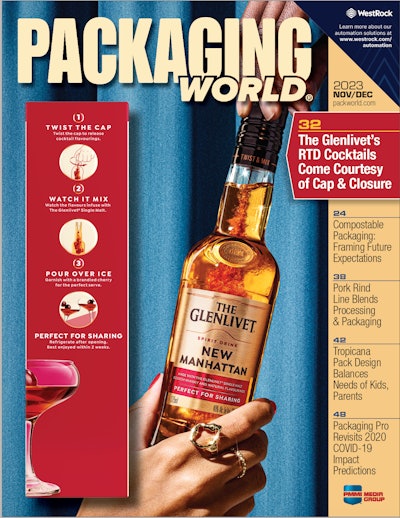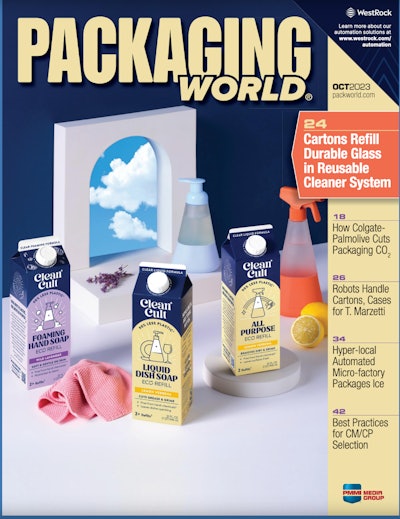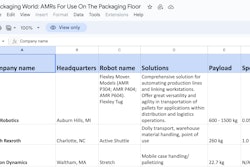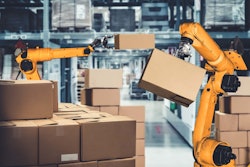One of the main drivers for AMERIPEN and PMMI’s upcoming 10-Year Packaging Material Compass is trying to understand packaging and packaging recovery as the recycling community clamors to better understand and adapt to the future of packaging. AMERIPEN’s Kyla Fisher and PMMI’s Rebecca Marquez join the unPACKed with PMMI pod to explain the need for this tool to see into the future about potential legislation, what consumers and CPGs are going to be looking for in sustainable packaging and what changes OEMs will need to make to adapt to this new reality. It’s sure to be a terrific report, and this is just a taste of some of the early findings from the 10-year Packaging Material Compass.
To subscribe, rate, review, and find more unPACKED podcast episodes, visit pmmi.org/podcast or find us on Apple podcasts, Spotify, iHeart Radio or wherever you listen to your podcasts.
 | Read the full transcript below
|
Sean Riley:
So with all the fancy introductions out of the way, welcome to the podcast, Rebecca from PMMI and Kyla from Ameripen. Welcome ladies.
Kyla:
Thank you. Pleasure to be here.
Sean Riley:
So many of our podcasts have been based around sustainability, and how sustainability is becoming more than the buzzword it was before and more as, whether it's a lifestyle or a part of manufacturing, it's just something that is impacting pretty much everything. And to kick things off, I know that's how you guys came together, so what is the main objective of the PMMI and Ameripen 10-year packaging materials compass? What are we hoping to accomplish with it?
Kyla:
So when Ameripen was first established, one of our founding principles was to be proactive with our policy and to be data-driven. And so, as we've reached out to stakeholders over the past couple of years trying to understand packaging and packaging recovery, particularly what we hear from their cycling community is that they need to better understand the future of packaging. And on average, it takes about ten years to redesign a MRF and about five to 10 years for policy.
So insights into packaging in a 10-year timeframe can help with better planning. And so our goal here was to start that dialogue is to understand you oftentimes get a five-year packaging forecast, but we don't get anything further in there. So we wanted to have the bigger picture and then what's the implications of this, and move forward from there. And PMMI has been a longstanding partner of Ameripen right from the get-go when we were first founded and seemed like a natural partner to help us with this study.
Sean Riley:
That makes complete sense. Now I have heard this word a million times, but I'm going to butcher it. Could you explain to our audience what a MRF is?
Kyla:
Thank you, I should have corrected that.
Sean Riley:
That's fine.
Kyla:
Yes. Municipal recycling facility. So when you're recyclables get picked up at the curbside, assuming you're in an urban environment, it will go to one facility where all of that is dumped and then sorted into different commodities.
Sean Riley:
Yes. And like I said, I knew I was going to mess up whatever the letters were, but I've heard so much about this now from doing this, and from what I understand, that is one of the barriers that is the hardest part of getting all this going, is that there are so many different MRFs out there, correct?
Kyla:
Correct. So many different MRFs and so many different community programs that accept different materials.
Sean Riley:
Okay. So that was a sidebar. We could go back to... So sorry if I cut you off, Rebecca. Please continue.
Rebecca:
Well, I think, I think Kyla did an excellent job of describing what we're hoping it will accomplish in terms of the industry that she is mostly involved in. And for us, I think the big thing for business intelligence or custom research is to just make sure that our members have some tool to see into the future and what their customers are going to be looking for, and what changes they'll need to adapt to this new reality. We want to be able to have our members look toward innovation and being able to meet the sustainability needs of their clients. And that's the big goal for us, honestly, and really to become more involved in the sustainability space as an organization.
Sean Riley:
Yeah. And that's the thing, I think everyone took care of the low-hanging fruit for the first 10 to 15 years of sustainability popping up as a word that they need to incorporate into their manufacturing, and now it has finally reached where we need to worry about it from the machinery standpoint and the material standpoint and yada yada. So with that in mind, what are you guys seeing in the data so far that's going to influence material usage in the next decade?
Rebecca:
Currently we have a couple of surveys in the field right now, and the way we're approaching this study is we're actually doing three separate surveys, one for materials and converters suppliers, one for OEMs, and one for CPGs.
Sean Riley:
Interesting.
Rebecca:
And the CPG survey is already closed. So that's what I'm going to be speaking about today is what CPGs are saying. So right now, what we're seeing that's going to impact materials usage the most, there are a couple of different things, and I'm sure you've probably heard this with other people that you've spoken with or heard this at meetings that really changes won't be made until consumers make the decision to spend more money to buy things in sustainable material packaging. And to some extent, that's what CPGs believe too. 71% either somewhat or very much agree that it is going to impact their future decisions about materials usage.
But really above that is legislation, and that's what CPGs are saying is really going to impact in the future their materials usage. And we're going to talk more about legislation probably later, but that seems to be the big thing right now. For our members also, we did ask about machinery being a limitation. So 52% of CPGs believe or agree or somewhat agree that machinery does have limitations. Packaging machinery does have limitations that are preventing them from accomplishing its sustainability goals. So it's not super high, but it's more than half. And so that really is something that can't be ignored by our members. It's something that they should absolutely be paying attention to, and we should be paying attention to as an industry. But the big one right now is legislation and what that's going to mean for people.
And in terms of legislation, what's on everybody's mind right now, and what is pretty much one of the main topics of conversation, is EPR, and that's extended producer responsibility. And four states have already enacted EPR laws, and that's Maine, Colorado, California, and Oregon, and other states that I've spoken with representatives from. It's on the table for them as well. And it has the potential to be complicated if all states are vastly different from each other. So we're not really sure how that's going to play out, but that's what I'm trying to get at with the rest of this study is to find out how exactly this is going to impact people in the industry.
Sean Riley:
So I'm sorry, could you give an example of how that legislation, it could be any state, let's just use state A, how that's going to impact whether it's the machinery, the materials, how that new legislation would impact them.
Rebecca:
So I think that legislation is just going to put the onus on CPGs to be responsible or accountable for the materials that they're using in their packaging, which may prompt them to change the materials that they're using to package their goods. So if they have something that they're using for packaging, for example, multi-materials that are impossible to recycle, then fees will be given out. And hopefully, that revenue from fees will go to improving recycling infrastructure in the United States. Those are all details that have to be determined, but that's, I think, probably how it's going to impact materials usage. If there really are problematic materials that are difficult or impossible to recycle, do CPGs want to continue using those materials, or will they opt to change for more sustainable materials?
Kyla:
And I think building on that, this is what I found fascinating about the data is if you look at our current legislation right now, and our current public dialogue, there's this pushback against plastics and particularly around plastic films. And yet, the data tells us that most packaging designers want to see more films and are looking at transferring out of certain types of packaging formats more towards these films. The other one that is interesting from a legislative standpoint is compostables. More and more package designers are saying in the next 10 years that, they want to be exploring more compostables. But legislatively, we have challenges in compostables. Number one, we don't have enough infrastructure.
Number two, of the infrastructure that we do have, a lot of those composting facilities don't want compostable packaging. And so this opens up a whole new dialogue around how do we set up our policy. Is our policy right now tackling things that design is not going with? Will the design change, or are they already anticipating some of these? There are just a lot of questions that some of this opens up, I think.
Sean Riley:
Yeah. And it's interesting because you said earlier that CPGs are looking for the consumers to make that decision simply because of cost, which is how pretty much every decision is made. And now it seems that the CPGs are not calling on but are being led by legislators who are going to add cost to them if they don't comply with these more sustainable materials. So while obviously, again, it all circles around money, it's interesting that it's moved from consumer to now, it's still on me to put the bottle in the recyclable container, but it's putting it more on big business to make sure that they take care of it on their end of it. So that is interesting.
And I don't know if this is something you guys know the answer to. Is there any move towards a more federal level of this, or is it still just state?
Kyla:
In the discussions that we're having, there is a desire to see more federal coordination. I think there's an absolute fear. While industry has become more supportive of EPR because they do see it as a way to close that loop and make packaging more circular, where 10 years ago they might have fought against EPR, there is this fear now, but we can't have EPR in 50 states. We need to coordinate it a little bit differently. Ameripen being a lobbying association, we don't have high hopes that you're going to get most of your activity at the federal level. We're certainly working on the federal level. You're seeing more initiatives with the EPA and their national recycling strategy, the passing of numerous more recycling bills, but I think we may need to be creative.
I look at Canada, and Canada has a very similar legislative environment around waste and recycling in that each of the provinces is responsible for its own strategies. And what they've done is they've coordinated a provincial working group so that they harmonize their EPR fees. They harmonize their EPR practices, and the federal government's not directly involved, but each of the provinces is working, and maybe that's what we need here. But with that said, we're certainly working at a federal level and trying to pass that message that we absolutely need better coordination if we're going to work this way.
And I think I'm digressing a little bit, bare with me, but I think that also speaks to recycling too. One of the things that you hear is recycling is done at a local level. And so I live in Phoenix. I go to work in Chandler. What I can recycle in Phoenix is very different than what I'm recycling 40 minutes down the road in Chandler. And that's incredibly frustrating for the consumer. And so, do we need to start looking at recycling from a more coordinated level? Whether you call it a MRF shed, looking at who feeds into these municipal recycling facilities, or do we standardize it at a national level? But just make it really easy and clear that what you can recycle at home is the same as what you can recycle at work or on vacation.
Rebecca:
And building on what Kyla said, it is different from here from county to county or city to city, but in talking with recyclers or state officials who are involved in recycling programs in their area, there is an attempt now to coordinate with other states. So I just recently spoke to someone from Connecticut. That state has a hundred percent accessibility to recycling facilities for all of its citizens. Then they will also coordinate with other states. They will talk to people and other recyclers from California or from the Southeast. So there is some coordination, but it has to be major involvement, I think, by all of them to get some standardization. And no one I've spoken with is super optimistic about federal standardization. Maybe there could be some decisions for the big areas of these initiatives, but it's really, I think, in just the people that I've spoken to so far, it is going to be down to the states.
Sean Riley:
Right. Which then leads to the same situation that we're dealing with now. I am thinking of plastic as an example, the plastic bags you get at a convenience store or something. I can go into one town where they're banned, and I can go to the next town where they'll give me five of them, and that's just a simple example, but making that on a larger scale, that's creating a lot of waste. It's making it pointless to even stop it in one place if you're still creating so much more right next door.
So are there any other things that you are hearing, Kyla, from members or others in the industry that are needed to better align material usage and recycling beyond what you've already said?
Kyla:
Yeah. I think there are a couple of things. We've talked about EPR a number of times, but I think one of the things that strikes me as we go through these dialogues is this interest in EPR, not just as a funding mechanism, which is really how it got started, but more as a way to get designers to help coordinate and feed insight into the recycling system. So there's interest in this study because it's the first time that the packaging industry is talking to recyclers and saying, "Hey, this is what's coming down the pipeline." And so there's more desire to see this, and EPR is seen as a way to do that. I think the other thing that we're hearing is there are still underutilized materials in the recycling system that we need to focus on. We still have 50% of Americans who have curbside access, don't quote me on that, but have universal curbside access.
So some people don't necessarily recycle because they have to pay for services, or it's really complicated to get services, or there are depots. And so if we can streamline that, we can get more paper, we can get more PET. Ameripen did a study a couple of years ago where we looked at corporate goals for recycling and then the available, so our demand essentially for PCR, and then the available supply and capacity of PCR. And what we found is in almost every case, we didn't have enough supply, and we didn't have enough capacity. And so that speaks to the fact that designers are interested in PCR, and designers want to reuse it. We need to increase collection. So we need to be looking at ways to improve that system, just basic access.
But then the other side is how do we sort it better, so we're not losing good material to poor contamination? And then the last one that really struck me as this goes through, and I talked about it a little bit earlier, is that idea of composting. We have this robust discussion around recycling, but if more and more packaging designers are moving towards compostable packaging, we know that food waste is an issue in this country, then we need to start having more robust discussions around expanding composting infrastructure and looking at ways that we can leverage both packaging, compostable packaging and food waste together.
Sean Riley:
Very interesting. Now having said all that, Kyla, Rebecca, are you seeing, from the data that you've been able to pull in so far, are you finding things in the survey that are jiving with this, that see this as a possibility?
Rebecca:
Absolutely. When I look at open-ended responses from CPGs in our survey, infrastructure is the big one. They're really, and I'm hearing this in interviews as well. Infrastructure is problematic; as Kyla was saying, only 50% of Americans have access to recycling programs. It could be a lot, a lot higher. But not only that infrastructure for access for consumers but also the infrastructure for the MRFs because we just had a conversation earlier today with recycling officials and state officials, where MRFs are not going to act on something unless it can keep them in business. And that's going to require changes to their own infrastructure as well.
So all around, whatever decisions are made at the federal level, at the state level, the monies that are collected, if we go in the direction of an EPR, have to go to improving our infrastructure. And I'm hearing that in the survey, I'm hearing it at interviews, it absolutely jives with what Kyla is saying,
Kyla:
But I think the strength of this study is making sure that we have the insights of what is that infrastructure to go for? And I think up until now, we've had people's, "Hey, I think this is the infrastructure that we need." And so again, when you look at the discussion around films, people are saying, "Well, we're going to phase plastics out. So we don't need infrastructure into plastics." Well, that's not what our data is telling us. Our data tells us that plastics are going to continue to grow, and there are a number of reasons why plastic is going to grow. And these counter-veiling forces, the rise of e-commerce, which makes flexible films more viable, counteracts with the desire to reduce plastics. And so we need to have that discussion, and we need to have it soon so that we're not investing in the wrong infrastructure.
Sean Riley:
So we started with MRFs, and I think we're probably going to end up talking about MRFs at the end of this, but I understand exactly what you're saying. As I said, I've done a bunch of these, but I learned a lot from just listening, and I'm sure our listeners at home will also. So I want to thank you, Rebecca, and Kyla, for taking time out of your day to come on here and talk about it. And hopefully, we can have you on again to discuss some of the other surveys as they come in.
Kyla:
Yeah, I would welcome that.
Rebecca:
Absolutely.
